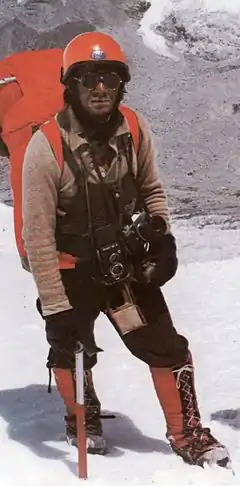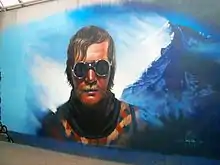Jerzy Kukuczka
Józef Jerzy Kukuczka (24 March 1948 in Katowice, Poland – 24 October 1989 Lhotse, Nepal) was a Polish alpine and high-altitude climber. Born in Katowice, his family origin is Silesian Goral.[1] On 18 September 1987, he became the second man (after Reinhold Messner), to climb all fourteen eight-thousanders in the world; a feat which took him less than 8 years to accomplish. He is the only person in the world who has climbed two eight-thousanders in one winter. Altogether, he ascended four eight-thousanders in winter, including three as first ascents. Along with Tadeusz Piotrowski, Kukuczka established a new route on K2 in alpine style (the so-called "Polish Line"), which no one has repeated.
 Jerzy Kukuczka on Mount Everest, 1980 | |
| Personal information | |
|---|---|
| Nationality | Polish |
| Born | 24 March 1948 |
| Died | 24 October 1989 (aged 41) |
| Website | Virtual Museum of Jerzy Kukuczka |
| Climbing career | |
| Known for |
|
| First ascents | Gasherbrum II East, Biarhedi, Manaslu East, Yebokalgan Ri, Shishapangma West
|
| Major ascents | Four winter ascents on the eight-thousanders |

Eight-thousanders
Kukuczka is widely considered among the climbing community to be one of the best high-altitude climbers in history.[2] He ascended all fourteen eight-thousanders in just seven years, 11 months and 14 days; he held the world record for shortest time span to summit the eight-thousanders for nearly 27 years until May 2014 when Kim Chang-ho beat his mark by one month and eight days.[3] Unlike many prominent high-altitude climbers of his time, the routes Kukuczka chose on the Himalayan giants were usually original, many of them first ascents and often done in the grip of winter wind and cold.[4] During his career, Kukuczka established ten new routes (still unbeaten record) and climbed four summits in winter. He was one of an elite group of Polish Himalayan mountaineers who specialized in winter ascents (called Ice Warriors).
In an era in Poland where even the most basic foods were scarce, Kukuczka was able successfully to mount and equip numerous ventures to the far-flung reaches of the world. Usually pressed for cash and equipment, he painted factory chimneys to earn precious złotys to finance his mountaineering dreams.[4]
| Year | Location | Mountain | Route | Comments |
|---|---|---|---|---|
| 1979 | Nepal | Lhotse | West Face | Normal Route |
| 1980 | Nepal | Mount Everest | South Pillar | New Route |
| 1981 | Nepal | Makalu | Variation to Makalu La/North-West Ridge | New Route, Alpine style, Solo |
| 1982 | Pakistan | Broad Peak | West Spur | Normal Route, Alpine style |
| 1983 | Pakistan | Gasherbrum II | South-East Spur | New Route, Alpine style |
| 1983 | Pakistan | Gasherbrum I | South-West Face | New Route, Alpine style |
| 1984 | Pakistan | Broad Peak | Traverse of North, Middle, Rocky and Main Summits | New Route, Alpine style |
| 1985 | Nepal | Dhaulagiri | North-East Spur | Normal Route, First Winter Ascent[5] |
| 1985 | Nepal | Cho Oyu | South-East Pillar | Second Winter Ascent |
| 1985 | Pakistan | Nanga Parbat | South-East Pillar | New Route |
| 1986 | Nepal | Kanchenjunga | South-West Face | Normal Route, First Winter Ascent |
| 1986 | Pakistan | K2 | South Face | New Route, Alpine style |
| 1986 | Nepal | Manaslu | North-East Face | New Route, Alpine style |
| 1987 | Nepal | Annapurna I | North Face | Normal Route, First Winter Ascent |
| 1987 | China | Shishapangma | West Ridge | New Route, Alpine style, Ski Descent |
| 1988 | Nepal | Annapurna East | South Face | New Route, Alpine style |
He climbed all summits, except for Mount Everest, without the use of supplemental oxygen.
Death
Kukuczka died attempting to climb the unclimbed South Face of Lhotse in Nepal on 24 October 1989. He was leading a pitch at an altitude of about 8,200 metres (26,900 ft) on a 6 mm secondhand rope he had picked up in a market in Kathmandu (according to Ryszard Pawłowski, Kukuczka's climbing partner, the main single rope used by the team was too jammed to be used and the climbers decided to use transport rope instead). When he lost his footing and fell, the cord was either cut or snapped from the fall, plunging Kukuczka ~2000 metres to his death. Kukuczka's body was never found, but the official version was that he was buried in an icy crevasse near the place of fall. Such a step was dictated by the need to find the body to pay compensation to the deceased's family.
Commemoration
In the hamlet of Wilcze in Istebna in the highlander's summer house Jerzy Kukuczka, there is the Memorial Chamber of Jerzy Kukuczka, created in 1996 by Cecylia Kukuczka (Jerzy's wife).
The mountain "Yak Hotel" in Nepal in Dingboche (4400 m a.s.l.) is named after Jerzy Kukuczka.
There is also a street in the Gaj housing estate in Wrocław named after him.
 Jerzy Kukuczka's memorial with Lhotse in the background
Jerzy Kukuczka's memorial with Lhotse in the background Memorial plaque in Istebna
Memorial plaque in Istebna Monument of Polish mountaineers in Katowice
Monument of Polish mountaineers in Katowice
See also
Bibliography
References
- Kukuczka, Jerry (2015). "Challenge the Vertical".
- Doubrawa-Cochlin, Ingeborga. "A Tribute to Jerzy Kukuczka (1948–1989)" (PDF). The Alpine Journal: 32–34. ISSN 0065-6569. Retrieved 9 September 2020.
- "Korean Everest Sea to Summit marred by tragedy". British Mountaineering Council. 27 May 2013. Retrieved 9 September 2020.
- Ruggera, M.D., Gary (1993). "Book Reviews: My Vertical World. Jerzy Kukuczka". American Alpine Journal. 50: 300–301. Retrieved 9 September 2020.
- "Xexplorers web:The meaning of winter in 8000+ climbing". Archived from the original on 7 August 2016. Retrieved 20 June 2013.
External links
| Wikimedia Commons has media related to Jerzy Kukuczka. |
